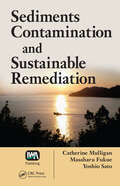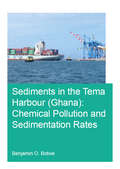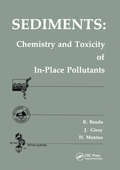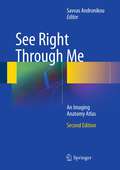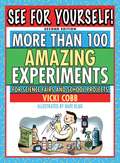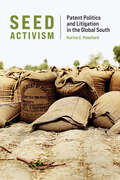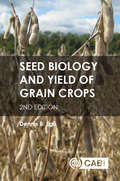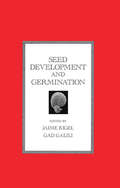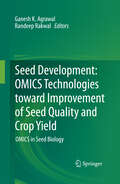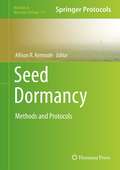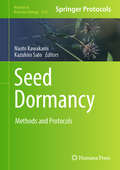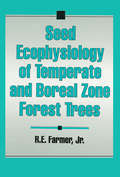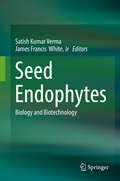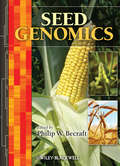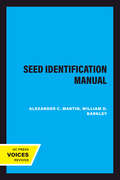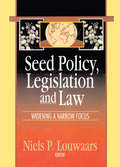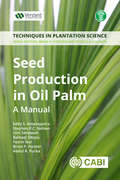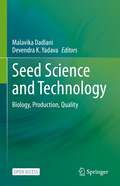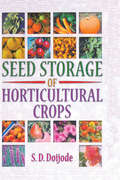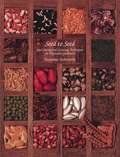- Table View
- List View
Sediments Contamination and Sustainable Remediation
by Catherine N. Mulligan Masaharu Fukue Yoshio SatoAlthough valuable resources in river basins and other aqueous environments, sediments often receive much less attention from researchers, policymakers, and other professionals than other components of the ecosystem. Until now. Highlighting the important role that sediments play in the geoenvironment, Sediments Contamination and Sustainable Remediat
Sediments in the Tema Harbour: Chemical Pollution and Sedimentation Rates (IHE Delft PhD Thesis Series)
by Benjamin O. BotweSediment pollution and accumulation in harbours are major environmental issues and studies that advance their solutions are essential for harbour sustainability. This book provides the first comprehensive assessment of chemical pollution in sediments and sediment accumulation rates in the tropical Tema Harbour (Ghana). This book contributes to improving our ability to use an integrated approach involving sediment chemistry and bioassays in one comprehensive assessment of the contamination state of a tropical coastal environment. Whole-sediment toxicity bioassays using the amphipod Corophium volutator and the polychaete Hediste diversicolor as bioindicators were combined with data on concentrations of total metal and metal binding forms, radionuclides, organochlorine pesticides and polycyclic aromatic hydrocarbons in bottom sediments as well as total metal concentrations in settling silt-clay particles collected by sediment traps to characterise the hazard, risk and impact of sediments from the tropical coastal Tema Harbour.
Sediments: Chemistry and Toxicity of In-Place Pollutants
by Renato BaudoThis important volume-the product of a meeting of a select group of scientists-provides the most recent research results from the world's leaders in the study of toxic pollutants in sediments.It gives practical information on measuring and mapping distributions of concentrations of pollutants and their toxic effects in sediments. Also covered are the use and relative advantages and disadvantages of benthic chambers, sedimentation traps, box corers, "peepers" and other sampling techniques in sediment research and assessment.Important topics covered include: bioassay, elemental speciation, diffuse source problems, nutrient flux, biomethylation, bioavailability, and toxicity assessment.Will help in assessment and monitoring of chemistry, dynamics, bioavailability, and toxicity of pollutants, as well helping to chart courses for remedial action.This book will be of interest to anyone interested in the processes controlling the chemistry and movement of pollutants in sediments, especially:limnologistsaquatic toxicologistsengineerslake managersecologistsbiologistsenvironmental chemists
See How They Grow Pets (See How They Grow)
by DKLet your little nature lover follow their favorite animals as they grow and change in the first weeks and months of their lives.This children&’s picture book is a must for fans of cute pets! Your child will meet a lovable puppy, a fluffy kitten, a delightful baby rabbit and many more in this charming introduction to animal life stages. Perfect for preschool children ages 3-5, this adorable animal book captures in beautiful detail how animals grow and develop. It's packed with: • Five different young animals at different stages of their early lives. • Beautiful photography and text that will help instill a lifelong love of animals, nature and books. • &“Puppy&” spreads that feature brand-new photography. Ready, set, grow! This wonderful activity book brings baby animals to life through beautiful, crisp photography. It follows them through their early lives — from helpless newborns to confident, curious creatures on the cusp of adulthood. See a bunny growing fur, kittens learning to hunt and a puppy playing with toys.Packed with fun facts and delightful read-aloud text, this nature book is ideal for developing your child's vocabulary. It has lots of opportunities for parent-and-child interaction and hours of baby animal fun! It's the ultimate bedtime storybook for little animal lovers.Your budding zoologist can discover how other wonderful animals grow too! Look out for more titles in this elegant series of children&’s educational books from DK like See How They Grow Kitten, See How They Grow Bunny/Rabbit, and See How They Grow Pony/Foal.
See How They Grow: Farm (See How They Grow)
by DKLet your little one follow their favorite baby animals as they grow and change! Go on a farm adventure like no other! Along the way, you&’ll meet a little lamb, a darling duckling, a playful piglet, and more in this adorable introduction to animal life stages. If there&’s one thing kids can&’t get enough of, it&’s baby animals. In this series of three engaging children&’s books, baby farm animals come to life through exquisite, crisp photography that shows the early stages of their lives. From a helpless newborn to a confident, curious creature on the cusp of adulthood, this charming animal book captures in beautiful detail how farm animals grow and develop. Perfect for children aged 3–5 years, See How They Grow: Farm will instill a lifelong love of animals, nature, and reading.Ready, Set, Grow! A series of clear photographs show the same animal at several different stages in its early life. Your child can discover how a chick hatches from its egg and how a duckling&’s feathers turn from yellow to white. Packed with fun facts and easy-to-follow text, this nature book is ideal for reading aloud and developing your child&’s vocabulary. This activity book provides lots of opportunities for parent-and-child interaction and hours of farm animal fun! It&’s the ultimate bedtime storybook for little animal-lovers. Complete the Series:Let your budding zoologist discover how other wonderful animals grow and change! Look out for more titles in this elegant series from DK Books such as See How They Grow: Pets, See How They Grow: Woodland Animals, and See How They Grow: Zoo Animals.
See It with a Small Telescope: 101 Cosmic Wonders Including Planets, Moons, Comets, Galaxies, Nebulae, Star Clusters and More
by Will KalifHave Fun Exploring the Stars with Close-up Views of Space Objects Right from Your Own BackyardTake the mystery and struggle out of discovering new worlds. With hands-on tips, tricks and instructions, this book allows you to unleash the full power of your small telescope and view amazing space objects right from your own backyard, including:• Saturn&’s Rings• Jupiter&’s Moons• Apollo 11's Landing Site• Orion Nebula• Andromeda Galaxy• Polaris Double Star• Pegasus Globular Cluster• And much, much more!
See Right Through Me
by Savvas AndronikouThis atlas demonstrates all components of the body through imaging, in much the same way that a geographical atlas demonstrates components of the world. Each body system and organ is imaged in every plane using all relevant modalities, allowing the reader to gain knowledge of density and signal intensity. Areas and methods not usually featured in imaging atlases are addressed, including the cranial nerve pathways, white matter tractography, and pediatric imaging. As the emphasis is very much on high-quality images with detailed labeling, there is no significant written component; however, 'pearl boxes' are scattered throughout the book to provide the reader with greater insight. This atlas will be an invaluable aid to students and clinicians with a radiological image in hand, as it will enable them to look up an exact replica and identify the anatomical components. The message to the reader is: Choose an organ, read the 'map,' and enjoy the journey!
See for Yourself!: More Than 100 Amazing Experiments for Science Fairs and School Projects
by Vicki CobbWith See For Yourself, budding scientists can wow their teachers and classmates (and maybe win a ribbon or two) by learning How to extract DNA from an onion How pigments from vegetables make dye How to make paper out of lint from a clothes dryer How to make a friend feel like he or she has a third hand What happens when you grow yeast in dandruff shampoo That tea and iron pills make excellent inks And much more! See for Yourself includes experiments in the areas of chemistry, earth science, physical science, the human body, and technology, but the experiments all take their inspiration from very familiar places. The materials needed to execute the experiments can all be inexpensively purchased at the supermarket, the toy store, the hardware store, the stationery store, and the drugstore. Some of the experiments are quick and easy, while others are more challenging. Most include additional suggestions so that curious young scientists can keep on investigating.
Seed Activism: Patent Politics and Litigation in the Global South (Food, Health, and the Environment)
by Karine E. PeschardHow lawsuits around intellectual property in Brazil and India are impacting the patentability of plants and seeds, farmers&’ rights, and the public interest.Over the past decade, legal challenges have arisen in the Global South over patents on genetically modified crops. In this ethnographic study, Karine E. Peschard explores the effects of these disputes on people&’s lives, while uncovering the role of power—material, institutional, and discursive—in shaping laws and legal systems. The expansion of corporate intellectual property (IP), she shows, negatively impacts farmers&’ rights and, by extension, the right to food, since small farms produce the bulk of food for domestic consumption. Peschard sees emerging a new legal common sense concerning the patentability of plant-related inventions, as well as a balance among IP, farmers&’ rights, and the public interest.Peschard examines the strengthening of IP regimes for plant varieties, the consolidation of the global biotech industry, the erosion of agrobiodiversity, and farmers&’ dispossession. She shows how litigants question the legality of patents and private IP systems implemented by Monsanto for royalties on three genetically modified crop varieties, Roundup Ready soybean in Brazil and Bt cotton and Bt eggplant in India. Peschard argues that these private IP systems have rendered moot domestic legislation on plant variety protection and farmers&’ rights. This unprecedented level of corporate concentration in such a vital sector raises concerns over the erosion of agricultural biodiversity, farmers&’ rights and livelihoods, food security, and, ultimately, the merits of extending IP rights to higher life forms such as plants.
Seed Biology and Yield of Grain Crops
by Dennis EgliThis new edition of an established title examines the determination of grain crop yield from a unique perspective, by concentrating on the influence of the seed itself. As the food supply for an expanding world population is based on grain crops harvested for their seeds, understanding the process of seed growth and its regulation is crucial to our efforts to increase production and meet the needs of that population. Yield of grain crops is determined by their assimilatory processes such as photosynthesis and the biosynthetic processes in the seed, which are partly regulated within the seed itself. Providing a timely update in this field and highlighting the impact of the seed on grain crop yields, this book: · Describes all aspects of seed growth and development, including environmental and genetic effects on growth rate and length of the filling period. · Discusses the role of the seed in determining the two main yield components: individual seed weight and number of seeds per unit area. · Uses the concepts and models that have been developed to understand crop management and yield improvement. Substantially updated with new research and further developments of the practical applications of the concepts explored, this book is essential reading for those concerned with seed science and crop yield, including agronomists, crop physiologists, plant breeders, and extension workers. It is also a valuable source of information for lecturers and graduate students of agronomy and plant physiology.
Seed Development and Germination (Books In Soils, Plants, And The Environment Ser. #41)
by Jaime Kigel Gad GaliliThis text is intended for plant physiologists, molecular biologists, biochemists, biotechnologists, geneticists, horticulturalists, agromnomists and botanists, and upper-level undergraduate and graduate students in these disciplines. It integrates advances in the diverse and rapidly-expanding field of seed science, from ecological and demographic aspects of seed production, dispersal and germination, to the molecular biology of seed development. The book offers a broad, multidisciplinary approach that covers both theoretical and applied knowledge.
Seed Development: OMICS Technologies toward Improvement of Seed Quality and Crop Yield
by Ganesh K. Agrawal Randeep RakwalThe book is about the seed development in the model and crop plants. Seed development is a key step of the plant life cycle that determines the nutrient value of seeds - the life for human civilization, growth, and development. The nutrient value of seeds is mainly due to storage reserve products such as carbohydrates, lipids (triacylglycerols), and proteins. The book primarily focuses on application of the 21st century high-throughput technologies transcriptomics, proteomics, metabolomics, and systems biology in near complete understanding of the various processes involved in seed development in different crop plants. The book reveals how such technologies have revolutionized our understanding of the multilayer processes and regulations involved therein by generating large-scale datasets. Accumulated datasets provide basic knowledge to develop integrated strategies to eventually improve the nutritional value of plant seed and crop yield, a critical goal in food security issues around the globe.
Seed Dormancy
by Allison R. KermodeUnderstanding seed-related processes is of major social, environmental, and economic concern. The viability and vigor of seeds are the very basis for sustainable agriculture and forestry, and comprehending the molecular and cellular events underlying these processes will become increasingly important to many economical sectors and for species that provide the world's food supply. Seed Dormancy: Methods and Protocols covers analytical methods and approaches which have already lead to significant advances in the understanding of seed dormancy and germination. Chapters cover explanations of processes leading to the induction, maintenance, and termination of seed dormancy, the classification of different dormancy types, as well as an overview of protocols used for dormancy-termination of seeds of conifer species. This volume emphasizes methods essential for abscisic acid (ABA) analyses, including methods that have been important for receptor identification, analyses of ABA-catabolizing enzymes (the 8'-hydroxylases), and identification of novel signal transduction components, interacting partners, and/or response factors. The volume closes by addressing the development of new technologies, including spectroscopic methods (some of which allow for non-destructive sampling) as well as highly effective tissue-printing methods for seed dormancy research. Written in the successful Methods in Molecular BiologyTM series format, chapters include introductions to their respective topics, lists of the necessary materials and reagents, step-by-step, readily reproducible protocols, and notes on troubleshooting and avoiding known pitfalls. Authoritative and easily accessible, Seed Dormancy: Methods and Protocols features detailed methods that will prove invaluable for both applied and fundamental seed research.
Seed Dormancy: Methods and Protocols (Methods in Molecular Biology #2830)
by Naoto Kawakami Kazuhiro SatoThis volume provides basic and state-of-the-art methods for fundamental seed research and practical application. Chapters detail recent seed dormancy studies, basic methods for germination and longevity, seed imaging, sugar, chromatin analyses, QTL analysis, and GWAS protocols for diploid and complex hexaploid species. Written in the highly successful Methods in Molecular Biology series format, chapters include introductions to their respective topics, lists of the necessary materials and reagents, step-by-step, readily reproducible laboratory protocols, and key tips on troubleshooting and avoiding known pitfalls. Authoritative and cutting-edge, Seed Dormancy: Methods and Protocols aims to ensure successful results in the further study of this vital field.
Seed Ecophysiology of Temperate and Boreal Zone Forest Trees
by RobertE. FarmerThis is the first truly modern book solely devoted to seed reproduction of forest trees-from flowering to establishment, with emphasis on the interaction of environment with physiological processes.Focus is on seed function in natural settings and the application of information to natural regeneration of forests. This easy-to-read text addresses important principles and provides in-depth coverage of existing literature.Presentation of the information is organized to allow for a natural development of the main theme with full explanations of such important components as seed production, dispersal and germination, as well as the integral parts played by water, temperature, light, chemicals, animals, pathogens and aging.A highly useful book for investigators, practitioners or students.
Seed Endophytes: Biology and Biotechnology
by Satish Kumar Verma James Francis White JrThis book focuses on the importance and roles of seed microbiomes in sustainable agriculture by exploring the diversity of microbes vectored on and within seeds of both cultivated and non-cultivated plants. It provides essential insights into how seeds can be adapted to enhance microbiome vectoring, how damaged seed microbiomes can be assembled again and how seed microbiomes can be conserved. Plant seeds carry not only embryos and nutrients to fuel early seedling growth, but also microbes that modulate development, soil nutrient acquisition, and defense against pathogens and other stressors. Many of these microbes (bacteria and fungi) become endophytic, entering into the tissues of plants, and typically exist within plants without inducing negative effects. Although they have been reported in all plants examined to date, the extent to which plants rely on seed vectored microbiomes to enhance seedling competitiveness and survival is largely unappreciated. How microbes function to increase the fitness of seedlings is also little understood. The book is a unique and important resource for researchers and students in microbial ecology and biotechnology. Further, it appeals to applied academic and industrial agriculturists interested in increasing crop health and yield.
Seed Genomics
by Philip W. BecraftThis up-to-date review of seed genomics, from basic seed biology to practical applications in crop science, provides a thorough background understanding of seed biology from a basic science perspective. A valuable resource for advanced graduate students, post-docs, researchers and professionals in the Plant and Crop Sciences, this book brings together top researchers in the field to cover three general themes: genomic approaches to studying seeds, genomic analysis of basic seed biology, and crop seed genomics.A valuable resource for advanced graduate students, post-docs, researchers and professionals in the Plant and Crop Sciences
Seed Identification Manual
by Alexander C. Martin William D. BarkleyThis title is part of UC Press's Voices Revived program, which commemorates University of California Press’s mission to seek out and cultivate the brightest minds and give them voice, reach, and impact. Drawing on a backlist dating to 1893, Voices Revived makes high-quality, peer-reviewed scholarship accessible once again using print-on-demand technology. This title was originally published in 1961.This title is part of UC Press's Voices Revived program, which commemorates University of California Press’s mission to seek out and cultivate the brightest minds and give them voice, reach, and impact. Drawing on a backlist dating to 1893, Voices Revived</DIV
Seed Policy, Legislation and Law: Widening a Narrow Focus
by Neils P LouwaarsLearn what it takes to create and implement a truly successful seed policy!This unique book brings together international experts on seed policy and law. While other books approach the subject from the perspective of seed industry development and privatization, Seed Policy, Legislation, and Law makes clear that a successful national seed
Seed Production in Oil Palm: A Manual (Techniques in Plantation Science #1)
by Brian Forster Eddy S Kelanaputra Steven P. Nelson Umi Setiawati Baihaqi Sitepu Fazrin Nur Abdul R. Purba Peter D. CaligariThis is a practical guide to seed germination in oil palm for both breeding and genetic studies as well as commercial seed production. Oil palm is the top oil crop in the world and this manual provides step-by-step illustrated methods, written by practitioners actively engaged in oil palm seed production and breeding. Presenting sound practices based on scientific innovation and knowledge, this guide brings together the many aspects of seed germination in oil palm in one place. Promoting green, eco-friendly agriculture, this book covers: Health and safety considerations Pollination and harvesting Seed preparation, viability testing and moisture testing Seed processing for commercial production and breeding Based on experience and protocols, this is an invaluable manual for students and researchers in agriculture, plant breeders, growers and end users interested in the practicalities of oil palm seed production. It is also a valuable resource for training, for those entering a career in oil palm and as a reference for managers , to ensure best practices in maximising sustainability and production of this important crop.
Seed Production in Oil Palm: A Manual (Techniques in Plantation Science)
by Brian Forster Eddy S Kelanaputra Umi Setiawati Baihaqi Sitepu Fazrin Nur Abdul R. Purba Stephen P. NelsonThis is a practical guide to seed germination in oil palm for both breeding and genetic studies as well as commercial seed production. Oil palm is the top oil crop in the world and this manual provides step-by-step illustrated methods, written by practitioners actively engaged in oil palm seed production and breeding. Presenting sound practices based on scientific innovation and knowledge, this guide brings together the many aspects of seed germination in oil palm in one place. Promoting green, eco-friendly agriculture, this book covers: Health and safety considerations Pollination and harvesting Seed preparation, viability testing and moisture testing Seed processing for commercial production and breeding Based on experience and protocols, this is an invaluable manual for students and researchers in agriculture, plant breeders, growers and end users interested in the practicalities of oil palm seed production. It is also a valuable resource for training, for those entering a career in oil palm and as a reference for managers , to ensure best practices in maximising sustainability and production of this important crop.
Seed Regeneration in Cross-pollinated Species
by E. PorcedduThis book deals with the practical aspects in regeneration of field crop plants; regeneration of pasture plants; and regeneration of horticultural plants. It discusses the methods to increase seed stocks of cross-pollinated species.
Seed Science and Technology: Biology, Production, Quality
by Malavika Dadlani Devendra K. YadavaThis open-access edited book is a collection of 17 chapters, synthesized primarily from the lectures delivered by eminent Indian and international experts during a series of capacity-building programmes organised in India during 2020 and 2021 under the aegis of 'Indo-German Cooperation on Seed Sector Development', a component of the Bilateral Cooperation between the Governments of India and Germany. Seed Science and Technology, a multi-disciplinary subject, is advancing rapidly keeping pace with the development of improved plant varieties and other climate-resilient technologies. Knowledge of the underlying biological processes and application of appropriate technologies for variety maintenance and seed production; quality assurance, testing and enhancement; processing, packaging and storage etc., are important in a seed programme. Chapters presented in the book is a blend of basic seed biology covering seed development, maturation, dormancy, germination, vigour and invigoration, and seed deterioration; variety maintenance and production of genetically pure seed of open-pollinated and hybrid varieties in a few key field crops and vegetables, and fundamentals of seed processing, packaging and storage; and seed quality assurance systems followed in different countries; testing the essential components of seed quality including seed health, application of molecular technologies for precision in testing, and enhancement of seed quality. It concludes by identifying the key areas of future seed research and technology development. The book covers the fundamentals and recent advances of seed science and technology with the latest research information and an exhaustive and updated list of references on different topics. It is expected to benefit the students as well as the scientists, faculty members and seed sector professionals, working in the public and private seed sectors, certification authorities and seed producing agencies in India, and elsewhere.
Seed Storage of Horticultural Crops
by S.d. DoijodeMaintain viability with these techniques for proper seed storage!Healthy, viable seeds are the foundation for sustainable crop production, while poorly kept seeds can result in low germination and crop loss. Seed Storage of Horticultural Crops suggests appropriate strategies to help farmers and breeders store seeds of all kinds.
Seed To Seed: Seed Saving And Growing Techniques For The Vegetable Gardener
by Suzanne Ashworth Kent WhealySeed to Seed is a complete seed-saving guide that describes specific techniques for saving the seeds of 160 different vegetables. This book contains detailed information about each vegetable, including its botanical classification, flower structure and means of pollination, required population size, isolation distance, techniques for caging or hand-pollination, and also the proper methods for harvesting, drying, cleaning, and storing the seeds. Seed to Seed is widely acknowledged as the best guide available for home gardeners to learn effective ways to produce and store seeds on a small scale. The author has grown seed crops of every vegetable featured in the book, and has thoroughly researched and tested all of the techniques she recommends for the home garden. This newly updated and greatly expanded Second Edition includes additional information about how to start each vegetable from seed, which has turned the book into a complete growing guide. Local knowledge about seed starting techniques for each vegetable has been shared by expert gardeners from seven regions of the United States-Northeast, Mid-Atlantic, Southeast/Gulf Coast, Midwest, Southwest, Central West Coast, and Northwest.
